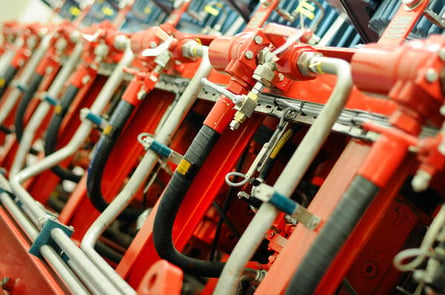
Hydraulic hose assembly requires special attention. In this blog post, Brennan discusses the two preparation options: skived and non-skived hose assemblies. There are benefits to both, depending on the situation and the grade of hose needed for the application.
Skiving
Skiving a hydraulic hose is the process of using special equipment and tooling to shave a predetermined depth of the outside diameter and inside diameter of the hose. Some medium-pressure hose fittings require only external skiving, called single skive, for the ferrule and hose fitting to fit together correctly.
Skiving lets the ferrule of the hose fitting assembly bite into the wire braiding of the hose instead of just crimping onto the outside diameter of the hose cover. If the hose is not skived, the thread of the ferrule is forced into the hose cover, biting into the rubber, which could result in a less reliable connection.
A skived hydraulic hose has a thicker hose cover, which means you must shave off some layers of the rubber cover to make it thinner for an easier insert of the fittings. Hydraulic hose skiving machines make it easy to skive hoses for use by removing the outer layer of the hydraulic hose at an automatically set depth. Skiving your hydraulic hose creates a tighter fitting, preventing any leaks or gaps and the potential of the fitting blowing off the end of the hose.
Higher-pressure hose applications may require internal and external skiving. Skiving a hydraulic hose ensures a metal-to-metal connection between the fitting and hose, resulting in a highly reliable connection. The skiving of both inside and outside of the hose is referred to as a double skive. Double skiving is most often used in high-pressure applications.
Once the assembly has been set, it is essential to correctly crimp the fitting onto the hose using the hose fitting manufacturers’ crimp specifications. Therefore, look for fitting manufacturers that can provide crimp specifications. If the fitting manufacturer does not provide the crimp specifications for a specific hose, the installer must adjust and pressure test to ensure the installation is accurate and secure.
Non-skiving
Non-skiving is when the hose and fitting connection is designed and ready to assemble without the skiving process, with no removal of material from the hose. If the hose is not skived, the thread of the ferrule is forced into the hose cover, biting into the rubber, which could result in a less reliable connection. Therefore, non-skived hose connections are used for low or some medium-pressure applications.
The hose core is not exposed to possible damage, as the cover or inner tubes do not need to be removed to attach the crimped fitting. Non-skive hydraulic hoses speed up the hose assembly process, with no additional equipment or clean-up needed. Additionally, non-skived hose connections avoid premature
hose failure caused by under or over-skiving. It offers an outer rubber cover to mechanically protect the steel wire reinforcement during hose fitting assembly.
Using no skived hoses eliminates the cost of skiving equipment. Non-skive hose assembly is the preferred choice for most low and medium-pressure applications. Using non-skived hydraulic hoses should be determined by the needs and budget of your project.
Conclusion
There is a major difference between skived and non-skived hydraulic hose connections. Not using the correct one can affect the function and safety of the hose assembly. Therefore, understanding what is needed for your application and whether your hydraulic hose needs to be skived or non-skived is crucial to ensuring the hose and fitting are connected properly.
This blog is an excerpt from our latest white paper titled "Hydraulic Hose Fittings: Four Things to Consider". Click here or the link below to download!
If you're interested in our line of hose fittings, click here to download our catalog.
Primary Sources Include:

